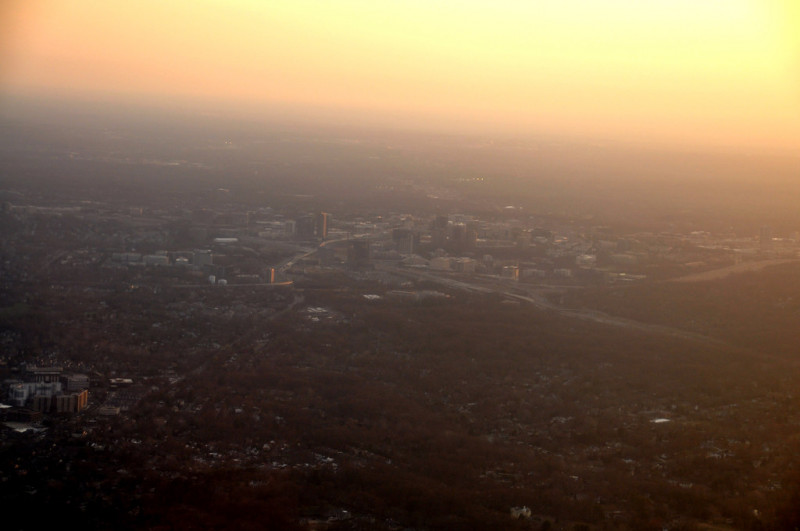Twenty years ago, it was common to have dozens of “Code Red” bad air days per summer

DC area Ozone-caused bad air quality days over time by Metropolitan Washington Council of Governments.
News in DC this week is all about the smoky “Code Red” air: how it’s harmful to breathe and how everyone should stay inside. These warnings are true. But did you know, as recently as twenty years ago, it was common for the DC area to have almost a full month’s worth of such days most summers?
They’re rare now because of anti-pollution regulations that work fabulously well.
All summer long used to be like this
Through the latter 20th century and the first decade or so of the 21st, DC and most large American metro areas had a terrible air pollution problem. Car exhaust reacted with sunlight to produce ozone, better known in cities as smog. It was visible just about every day, making the air look heavy and orange.
In the summers, as warm humid air hung over the city every afternoon, the smog wouldn’t dissipate, and we might not see a beautifully blue sky for weeks.
In the DC area, we typically got 20 or more Code Red days every summer, plus a handful of even worse Code Purples, and weeks upon endless weeks of ceaseless not-quite-so-bad Code Oranges.
Smog over Tysons a few years ago by the author.
The smog looked and smelled a bit different than this week’s Canadian fire smoke, but the effect on air quality was similar. And it used to happen all the time.
All summer long news programs would report on the air color grade every day, telling us whether or not the air was safe enough to have a backyard barbeque that day, or play a ballgame. Everyone millennial-aged or older remembers. It was as much a part of our lives as the weather.
And then, about a decade ago, those bad air days just stopped.
What does Code Red mean?
Look at the chart at the top of this post, from the Metropolitan Washington Council of Governments. It shows the number of days per year that the Washington region experienced Ozone-caused Code Orange, Code Red, or Code Purple days, from 1997 through 2022.
The color codes are a federally-defined Air Quality Index that combines the most common types of air pollution into an overall grade. It’s a kind of short-cut to quickly and easily communicate how good or bad the air is on any given day, overall.
This week, we’re experiencing Red because of the Canadian fires. Twenty years ago, we used to get a lot of Red—and Orange and Purple—because of smog.
But noticeable levels of smog have virtually disapeared from DC and many American cities over the past two decades, resulting in a 2023 in which just about the only bad air quality days are those that some outside event produces. Like smoke blowing over from a fire hundreds of miles away.
Why doesn’t this happen anymore?
How did we get smog to virtually disappear? In no small part it’s due to successful government regulation of cars.
The biggest change over the past two decades has been in emissions from cars. New ones pollute much less than old ones. Partly that’s thanks to hybrid and electric cars, but it’s also partly thanks to cleaner internal combustion engines. EPA Vehicle Emissions Standards force car-makers to build cleaner cars over time.
There are plenty of loopholes, and reducing smog isn’t the same as reducing climate-change-causing carbon, so there remains a long way to go, but a lot has been achieved.
It’s not only car emissions
Another big factor is the decline of coal power plants in the United States. A decade ago coal accounted for 34% of US power production. Now it’s 14%, and dropping fast.
Locally, the 2012 closure of a big coal power plant in Alexandria lines right up with the single most sudden decline in bad air days. It was a big deal.
Finally, land use and multimodal transportation of course make a big difference too. But while these greatly reduce emissions from the urban core and from new infill developent near Metro stations, they don’t do much to reduce emissions from existing 20th-century car-oriented suburban areas. They help explain how pollution hasn’t gotten worse, but the raw decline over older levels is mostly due to cleaner cars and power plants.
It’s a remarkable story of successful environmental intervention, and a reminder that our country can do great things, and make great difference.
Twitter user @bikemattic sums it up:
When I was growing up in southern California in the 1970s, it was a rare day in summer to see the mountains from the beach. Now it’s a rare day that you can’t - thanks to pollution controls on motor vehicles and industry, and air quality 𝘮𝘢𝘯𝘢𝘨𝘦𝘮𝘦𝘯𝘵.
— bikemattic (@bikemattic) June 7, 2023
